  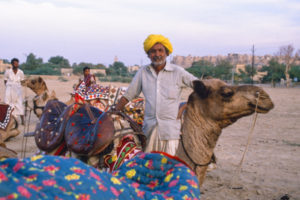 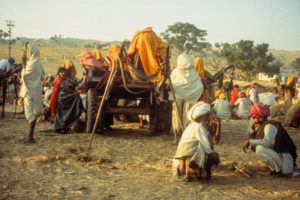    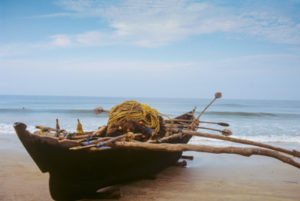 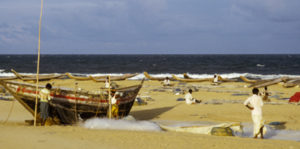 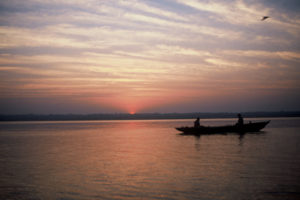 |
I love the Indian trains! This amazing system carries ten million passengers a day, over a distance equal to four round trips to the moon. If things don’t always work perfectly, this is the reason why! In spite of the occasional delays and snafus, I still feel like this is the best way to get to the soul of India and meet the people. Ideally, you would have a tour operator in India and pre-book your tickets (this can be done 3 months in advance and for major trains, should be done as soon as you can.) If you are going it on your own, one look at the official Indian Railway Catering and Tourism Corporation Limited website – www.irctc.co.in – might have you running for cover. Try “Make my Trip” at www.makemytrip.com There are problems getting the Indian Railways to accept foreign credit cards on line, and these people can help with that. It’s still complicated with all the wait lists, and different classes, but they can run interference for you. If you are backpacking and booking last minute, try to stay open and flexible. Some of my best experiences have happened because the train I wanted was full and I ended up with one of those serendipitous trips to some incredible place that I had no idea I wanted to go. The New Delhi Station, Calcutta, Mumbai and Chennai all have “Foreigner’s Booking Offices” which are staffed with very patient and very helpful clerks who will help you plan your trip and make reservations. Payment must be made with foreign currency, traveller’s checks. You can pay in Rupees only if you have an encashment certificate. If you are booking last minute, you may be able to land a “foreigner’s booking quota” seat. If you are a man over 60 or a woman over 58, you may qualify for a senior “concession”. Take a chain and padlock with you so that you can lock your bags to the bed. Also useful are a couple of bottles of water, a hand towel, and toilet paper. If you are travelling by yourself, be sure that all your valuables are in one bag that which you can take into the bathroom with you. It’s too dirty to set the bag down, so be sure you can hang it from the hook. Don’t go expecting a good night’s sleep. Trains are, to the Indians, an excuse for a party. Porters! A necessary (or at least very convenient) evil. They are the easiest way to find the right compartment on the right train and anyway those “up and over” stairs are murder. No matter what you pay them, they will scream and berate you, so here’s my way of dealing with them: Somewhere – usually between the booking windows and the entrance gate – there’s a blue sign with white writing that tells you what the approved charges are. Last time I did this, a “head carry” – which is what they will do if you have 2 bags – is 40 Rupees and includes 30 minutes of waiting time. Additional waiting time is another 40 Rupees. I take a picture of this with my cell phone. Technically – since I’m an early bird and arrive 30 minutes before departure – I owe them 80 Rupees, but since I am a wealthy (ha!) foreigner, I hand them about 125. It’s US$1.85 – totally worth it to me and these guys do work really hard and deserve a little bit of a break. When they start screaming at me, I pull out the photo on my cell phone an let them know that I really do know the score is. Everyone happy! The most reliable trains are the Rajdhani trains and the Shatabdi. The Rahdhanis are the long-haul trains originating from or bound to Delhi (“Raj” means “capital”). These trains link Delhi with Mumbai, Calcutta, Chennai, Hyderabad, Bangalore, and Guwahati (via New Jaipalguri for Darjeeling). The Shatabdis, India’s version of the superfast train, are chair cars linking Delhi with Agra, Bhopal (for Sanchi), Jaipur, Agmer (for Pushkar), Chandigarh, and Amritsar. They also run from Mumbai to Ahmedabad, and Chennai to Bangalore, Mysore, and Coimbatore. Other reasonably reliable trains are the “Passenger” and the “Mail” trains. Rail fares are strictly by the kilometer, unless you purchase an Indian Rail Pass. These are available in one to 90 day increments, but may not actually be the best deal. For instance, the 7 day Second A/C pass is USD135.00, but if you were to buy point to point tickets Delhi-Udaipur-Jodhpur-Delhi, you would pay USD 95.00. The staff at the booking office will help you work this out. What the pass does do for you, is to open up some additional tourist quota seats which may help you get on to an otherwise sold out train. Unlike Eurail tickets, these can be purchased in country at the Foreigner Booking Offices in major Indian cities. Payment must be made with Dollars or Pounds. Check out http://www.india-rail.com/indrail-pass.htm In a cruel, cruel blow to tourism, Indian Rail has taken off most of the first class non air-conditioned coaches which allowed the traveller to put the glass up, lean out, and enjoy the countryside as it rolled by. These have been replaced with coaches with double-glazed glass which is often so opaque that it is difficult to see out. The only way now to commune with the Indian countryside and take photos is to book second class, non air-conditioned. These coaches, however, are suffocatingly crowded and should be used with caution. Most trains will have one or more of the following options: By the way, I do believe everyone should have a 3C experience at least once in their lives. Preferably traveling with a friend and on a day trip not longer than 6 hours. First class air-conditioned – Abbreviated 1AC. Four people to a compartment which can be locked from the inside. Communal bathroom facilities are down the hall. Sometimes, you can nab a compartment made for 2 – it’s worth it to ask. They will try – but don’t always succeed – in separating travelers by gender. Second Class A/C (2 tier and 3 tier) – Abbreviated 2AC or 3AC. These air conditioned cars are similar to the European “Couchette” arrangement where a curtain separates you from you fellow travellers. In the “2 tier” coaches are arranged so that 4 people sit in one area, facing each other. (Six people in the “3 tier”.) Bunkbeds are arranged perpendicular to the sides of the train. Called “the inside”, this can be requested on your booking form. Across the aisle, 2 people (3 in the 3 tier) have bunk beds that are aligned parallel to the side of the train. These beds are a little bit narrower that the inside beds. The 3 tier is more crowded during the day when 3 people sit on the lower bed which is now the seat, but in both these classes, they will not oversell the number of beds. Meals are served and you will be given bedding for the night. Second Class, Non A/C (2 and 3 tier) – Abbreviated 2C or 3C, or sometimes SC (sleeper class) for the 3 tier. These coaches have wooden benches arranged in the same way as the air-conditioned class, but without the curtains. The windows will open and there are fans. No bedding is provided and the number of people with tickets usually exceeds the available seating. Ummm… Sometimes by rather a lot. Air Conditioned Chair Car – Abbreviated CC for chair car. These are found on Shatabdi trains with journey times of less than about 8 hours. Reclining, bus type seats are 6 across, with a center aisle, and are abbreviated CC. Meals and drinks are provided. On most Shatabdis, there is also an executive chair car class, abbreviated 1A, which has more legroom and upgraded seats. In addition to the various classes, the other issue to navigate is all the confirmation and quota variables. When you are making your reservation and the train appears to be sold out, you still may be able to nab a seat. A certain number of seats are set aside for people who may have had a disadvantage in the initial purchasing process. Like foreigners who had to navigate all this in their home country. First of all there are Tatkal Quota seats. Anyone can buy these if they are willing to pay up to 30% above the list price. There are Foreign Tourist Quotas, Ladies Quotas, and India Rail Pass Quotas. And probably more – be sure to ask. So now, what kind of ticket do you have? Besides an actual confirmed ticket, there are “reservation against confirmation” seats (RAC) which are essentially a waitlist, but you will be allowed on the train and the conductor will find something for you – although it could be a 3C berth – when you get on. A regular waitlisted ticket (WL) means you will not get on the train if there is not space. In other words, the RAC people are getting on first. Yikes! I have found that the “Woman in distress” ploy works best with recalcitrant booking agents. Sorry, but it’s true. There are a few train journeys in India that are an experience unto themselves. Train buffs might consider a journey on the Palace on Wheels or on one of the narrow gauge “Toy Trains”. The Silma-Kalka Express – This was the Viceroy Dalhousie’s pet project in 1845. One hundred seven tunnels make this one of British India’s most monumental – and still spectacular – rail projects. Take the regular broad gauge train from Delhi to Kalka and transfer to the toy train for the 6 hour ride to Simla. The Nilgiri Mountain Railway – This cute little train travels form Mettupatayam to the British hill station of Oottacamund (Ooty) in Tamil Nadu. They used this train to film the ride to the Malabar Caves in “Passage to India”. Begin this journey at Coimbatore and the train will be switched to narrow gauge at Mattupatayam. This is a really gorgeous ride, and Ooty is worth a night. Matheran railway – This ride is only about 1 ½ hours to the hill station of Matheran in Maharashtra, but has beautiful hill scenery. Take the Mumbai – Pune line, and pick up the toy train at Neral. The Darjeeling Toy Train – This track, at 2 feet, is the narrowest gauge in India. The journey begins in New Jaipalguri and takes 7 hours to wind its way up the Himalayan mountains. Often, villagers will run along side the train, chatting with you as you go. The train terminates about 30 minutes short of Darjeeling, in Ghoom, which is, at 7407 feet. If you don’t wish to spend 7 hours – instead of 4 hours by car – getting to Darjeeling, you can still have a good a very worthwhile train experience. Pick up a car and driver in Darjeeling and have him take you to Ghoom, then take the train to Kurseong. This one hour ride has the best of the mountain scenery. Your car can meet you in Kurseong and drive you back to Darjeeling. In 1999, this train was declared a UNESCO World Heritage Site. The Fairy Queen – This little engine is the oldest working steam engine in the world, and one of the very few remaining steam engines in India. During the tourist season of October to April, it takes weekly runs from the Delhi Cantonment station to Alwar and Sariska National Park. The $235.00 per person package departs on Saturday morning, includes game viewing, a night at the Siliserth lake Palace Hotel, and returns to Delhi on Sunday. The Palace on Wheels This is India’s most luxurious train and one of the most time efficient ways to see Rajasthan. If you want a quick over-view of the best of Rajasthan, this is a great way. The carriages are newly built, but in the most elegant royal Rajput style. Each coach has double bedrooms with attached bath, and a sitting area. You will have your own staff of butlers and waiters, making the service incomparable. There is a bar and a dinning room with excellent food. The train departs the Delhi Safdarjung Station on Wednesdays and stops at Jaipur, Chittaugarh, Ranthanbore, Udaipur, Jodhpur, Jaisalmer, Keoladeo National Park (Bharatpur) and Agra. Travel between the cities is done during the night, and sightseeing at each stop is included. Current high season prices run about $4550.00 per person, based on double occupancy. All meals and sightseeing included. Their web site is www.palaceonwheels.com. I loved this and would do it again, but in my opinion, the experience was somewhat marred by the fact that we were a group of about 80 tourists, shuttled around in huge busses, and followed by all the touts that you can imagine this type of group would attract. Just sayin’! It is operated by Rajasthan Tourism and the Indian Rails, so it may be best to book through a local Indian Tour operator. There is also a Maharajas’ Express that runs a variety of different itineraries, most of them from Delhi but also one from Mumbai. Also owned by Indian Rail, they are a bit more expensive but have won several awards for their service. www.maharajas-express-india.com Further reading: Around India in 80 Trains Monisha Rajesh. The first chapter is called “All Aboard the Insomnia Express” which alerts you to Ms. Rajesh’s impending wit and wry humor that make this such a fun book. If you are going to be on a lot of trains in India, this one will help you with the insider tips. It will also help you keep your sense of humor during those sure-to-happen trying moments. India by Rail – Royston Ellis. If you are planning really extensive train travel, your best bet is to pick up this little gem of a book. It is replete with anecdotes, tips, practical information, and tricks of the trade for negotiating the frustrating and confusing world of the Indian Rail. Third Class Ticket – Heather Wood. (Fiction) A poor Indian village woman bequeaths money to her fellow villagers so that they can take a train journey across India. A real glimpse into how Indians view India. My India – Jim Corbett. (Available in India) Before he was a big game hunter, Jim Corbett worked for the Bengal and Northwestern railway. This book, which is actually about his life in the Kumaon Hills, has some great reminiscences from his railway experiences. Anthology of Railway Stories – Ruskin Bond. (Available in India) One of the most prolific writers of Indian lore has some hilarious and insightful accounts of travel on the railways. Building the Railways of the Raj – Ian Kerr. A bit dry and technical perhaps, but a good historical account of the building of the railways. Newman’s Indian Bradshaw For serious gricers! (And if you know what that word means, this could be the book for you) Published monthly, it is three hundred pages of all the train minutia. Available in India, but it is a bit hard to find. |
